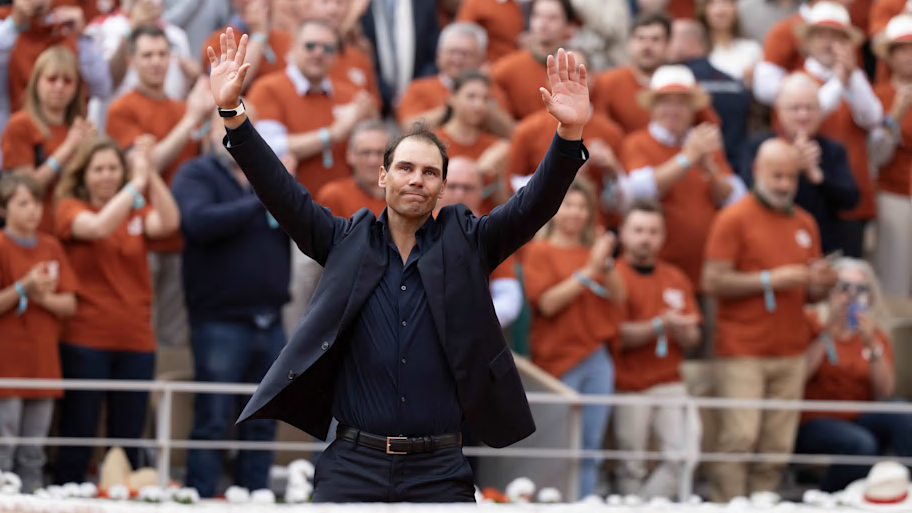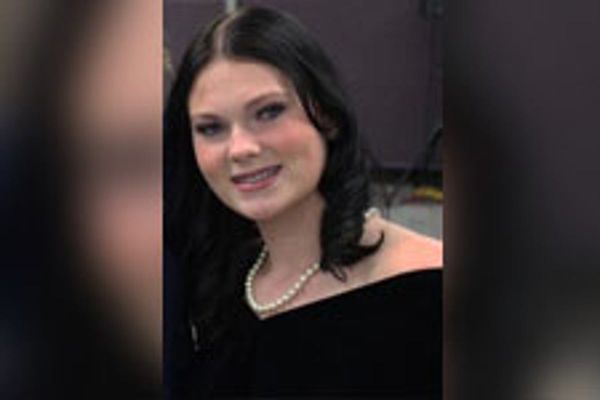
Hey everyone,
• A quick mailbag before Wimbledon. We’ll do Sports Illustrated’s Wimbledon seed reports when the draw comes out on Friday.
• Here’s the most recent installment of Served … Andy and I will do a draw preview crash-and-burn on Friday.
• Immodestly, thanks to all of you who wrote about Surviving Ohio State. The documentary game is a team sport. But make no mistake, the real MVPs here are the subjects who had the courage to go public. A few of you asked how to watch. I don’t know about international rights, but it’s streaming on HBO Max here.
• Good soldiering: Tennis Channel will do pregaming and postgaming from Wimbledon when ESPN goes off the air. Steve Weissman, Martina Navratilova and I will be at the All England Lawn Tennis Club. Prakash Amritraj, Brett Haber, Lindsay Davenport and Jim Courier will be in the studio.
Onward …
Remember that one time [Carlos] Alcaraz had a slump?
Yeah, he doesn't either.
Chris B.
• Remember that one time when Netflix aired a documentary about Alcaraz, themed around his wavering commitment to true greatness?
Hi Jon,
I was thrilled to be included in your mailbag a few weeks back. Pretty cool you (or someone on your team) are actually reading all these messages and taking the time to respond to fellow tennis nerds. Much appreciated.
I was excited to see the mixed doubles lineup that the U.S. Open put out this week. Wouldn’t it be incredible if we could find a way to get more top players in doubles action? No offense to M. Arevalo or M. Pavić (yes I had to look up the two top ranked men’s doubles players), but wouldn’t it be more exciting to see Alcaraz, [Jannik] Sinner or [Daniil] Medvedev on court more often? Occasionally, we see the top women teaming up and I find myself actually checking the scores and highlights to see who won.
I love the moving of mixed doubles to the week before the main action, but what about narrowing the doubles fields to 32 pairs and starting it in the final week of the slam? That way players who get knocked out early have a reason to hang around and compete. Instead of having insanely busy courts during the opening rounds, more courts stay in use throughout the tournament and fans might have more reason to go watch doubles.
I’m sure there’s a reason this hasn’t been tried before, but what is it?
Robert Henry
Tavira, Portugal
• Here’s where I stand on the U.S. Open bombshell mixed doubles announcement …
A) We often talk about how tennis needs to do a better job innovating, cultivating stars, rethinking old models, building casual fans, etc. When folks make an attempt like this, well, they aren’t entitled to a free pass—look, this could be an abject disaster—but they do deserve the benefit of the doubt.
B) We need to be realistic about the current status of mixed doubles. Here’s the field from Roland Garros. Without disparaging anyone, can we agree there is a marked difference in draw power and star power between this and the U.S. Open?
C) Not unrelated, we also need to be realistic about where mixed doubles figures into the tapestry of majors these days. In Paris, even the finals were played (on a Thursday) before a modest crowd and with no television coverage. The idea that we are trivializing a grand tradition is not an accurate reflection of the situation. Let’s not over-romanticize an event that even hard-core fans barely acknowledge.
D) Note that the brains and driving force behind this is Eric Butorac, one of the tennis forces for good, but, perhaps ironically, a former doubles player, precisely the kind of player who would have been excluded from this kind of star-driven event.
E) I don’t buy the argument: These players don’t need the money. They shouldn’t be taking from the doubles players. This isn’t the Brooklyn food co-op. This is a competition. If you want the prize, go win it. We would never say, Why is this team sport athlete taking an All-Star game position from another player who could benefit from the slot?
F) Note that there’s a difference between a tentative list issued in mid-June and the actual list of players who will play that week.
G) There has been so much chatter just based on the listed pairings. What do Sinner and Emma Navarro have in common? Why does Naomi Osaka insist on burning reputational capital on Nick Kyrgios? Where’s Coco Gauff, who actually excels at doubles? Doesn’t this level of interest, in itself, suggest a win?
H) If this is remotely successful, there’s no way other events don’t “copy” the concept. If it fails or comes across more as a gimmick than a legit title, put it in the category of the missed underarm serve. Good effort. Good attempt at a disruption. Now let’s go back to the conventional method.
Hey Jon!
I enjoyed today’s (6/18) mailbag discussion about possibilities for leveraging the recent televised success of Roland Garros for the betterment of our game.
At the same time, this NYT article seemed like a sobering glimpse into the future of sports fandom across major sports.
What’s your take on the likelihood of television rights for major sports events being swallowed up by the wealthy few?
Jim Lenker, Buffalo, NY
• I was a bit torn by this op-ed. It’s a fair point: It’s never been more expensive to be a sports fan. But, I thought it also had the ring of old tennis players lamenting that today’s stars are so wealthy they have entourages! My response: Yes, perhaps it would be nicer if there were more collegiality. But if players were still carpooling to events and sharing hotel rooms, something would be profoundly wrong. Entourages and private air travel and “teams” are an offshoot of the sport’s growth and success. Which was always the goal.
Likewise, yes, it would be nice if the U.S. Open grounds passes weren’t $250 … if we didn’t need subscriptions to watch our favorite sports and teams … if bottled water weren’t $8 at the concussion stand … if the Los Angeles Lakers were a civic trust and not a $10 billion business. But the market is the market. Supply doesn’t intersect with demand by accident.
As for tennis media rights, my guess is that they won’t be swallowed up. On the contrary, they will be parsed, not unlike the NFL and NBA media rights deals, and not unlike how tennis is split today. TNT might add to its Roland Garros package. ESPN is broadcasting three weeks per major at three majors. Tennis Channel has rights throughout the year. Amazon or another streamer might take another gander at tennis.
As long as there are multiple parties willing to pay, and as long as there is so much inventory, why commit to one outlet? Unfortunately, this means more subscriptions for us. But until/unless we opt out and the market changes, the media outlets will charge what they can.

Hello Jon,
Thank you for sending me your mailbag every week. Your writing and insights are always amazing and appreciated. I have a request. Once you printed an observation another player made about Rafa [Nadal]. The player talked about how Rafa always says hi to other players even if he had just lost a match. Can you either reprint or send me this tribute? I remember it as remarkable worthy of a life lesson I would like to share with others.
With appreciation,
Rashmi
• Thanks. Honestly, I’m not sure what you’re referring to, but it sounds on-brand for Nadal. It could be any of 100 players. (I would add: I’ve heard the same for Roger Federer and Novak Djokovic. Federer used to do a video for ITF juniors making the jump to the pros. He essentially played the role of the senior welcoming the freshmen. He even said words to the effect of, “If you have questions, don’t be shy, seek me out!”)
Here’s one story I like to tell. I always like talking to tournament drivers about their experiences. A few years ago, I asked a driver who was the nicest player she had shuttled to and from the venue.
“Federer or Nadal,” she responded.
“Okay,” I said. “But not just the stars. Of ALL the players, who treated you the best?”
“Federer or Nadal,” she said.
Hi Jon
Thanks for the Mailbag and 50 Parting shots. Always such a good read. In response to a letter from JB, PDX about the match tiebreak you wrote, “it spares us the absurdity of winning by a two-game margin.” While I’m happy to admit that I’m a traditionalist and a fan of the two game margin I don’t see how deciding a set by a two-game margin can be considered “absurd” when that is the standard way most sets are won? If anything is absurd it is arguably deciding a grand slam championship based on only a two point margin. A champion is the player who can break and hold. Great players can break. Great players win grand slam tournaments.
David, Adelaide, Australia
• “If anything is absurd, it is arguably deciding a grand slam championship based on only a two-point margin.” In the Roland Garros final, Sinner won 193 points and Alcaraz 192! It was a one-point margin. And the winning player had fewer total points!
Seriously, I appreciate your, well, point. I guess I should have said “potential absurdity.” When players win divisive sets 70–68—or even 16–14; or in a best-to-seven shootout at 12–12—it makes tennis look unserious. At 6–6, a 10-pointer versus a seven-pointer bakes in a bigger sample size.
Hi Jon,
What are tennis players looking for when they examine multiple balls from the ball crew before a serve? They even do it with new balls. I could see on clay that there may be some dirt on a ball and a player would not want to serve that ball. But most players do it on all surfaces, indoor and outdoor.
Serena Williams and Roger Federer never examined the balls; they just served the one given to them.
I do not recall ever seeing this addressed in your mailbag.
Jim Yrkoski, Silver Creek, Neb.
• It varies. Sometimes, certain balls are genuinely fluffy (or less fluffy) than others. After winning a point, some players superstitiously demand to play with the same ball. My theory: Some players might look as though they’re inspecting the ball as assiduously as a grandma examining fruit at the market, but in actuality, they’re just clearing their head.
I’ve noticed you correctly use the term “major” whenever you’re speaking about one title at a grand slam event. Andy (and many many others) use “major” interchangeably with “grand slam,” and that seems to short-change the achievement of winning all four majors (whether in a calendar year or over a career, either of which can be called a grand slam). After all, the term comes from baseball where not every home run is a slam. You need to drive in four runs (bases loaded plus yourself) to get a slam. You should need to win four different majors before you have a “grand slam.”
Novak has 24 majors. Rafa has 22 majors. Roger has 20 majors. All of them have a career grand slam. None won a calendar slam. Alcaraz has 5 majors, no slam (yet).
Zach
• You know how it is with Roddick. Can you trust anything that guy says? As it is written, a major is one of the four biggest tennis events. A Grand Slam is a Denny’s breakfast comprising two fluffy buttermilk pancakes served with two eggs made your way, two Applewood-smoked bacon strips and two all-pork sausage links.
HAVE A GOOD WEEK, EVERYONE!
More Tennis on Sports Illustrated
This article was originally published on www.si.com as Tennis Mailbag: U.S. Open Innovates With Mixed Doubles Format.







